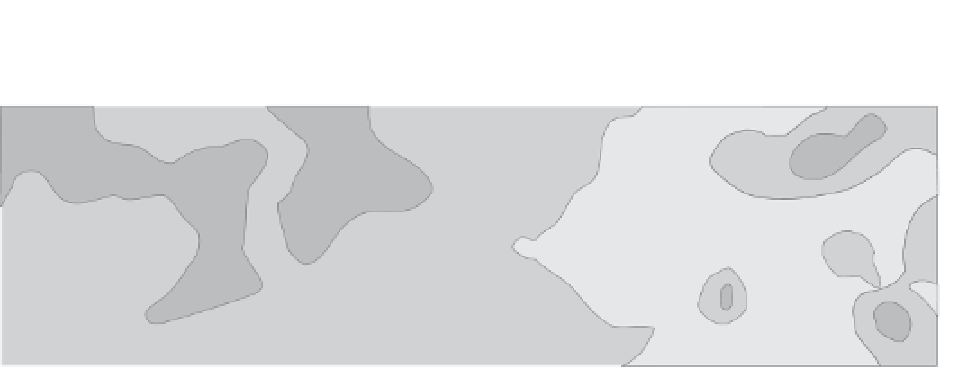Environmental Engineering Reference
In-Depth Information
0
10
20
30
0 0 0%
25
20
15
10
5
0
0
20
40
60
80
100
East (m)
Figure 11.2
Small-scale spatial distribution of the amount of bare soil covering planting holes (as shown by the grey scale,
in %; darker areas had more bare soil), and of seedling survival 1 year after planting. Crosses (+) and circles (•) are dead and
live seedlings, respectively. There is a signifi cant negative relationship between the amount of bare soil and survival (logistic
regression;
P
< 0.001). (Elaborated from Maestre
et al
. 2003a .)
soils. The array of available techniques is very large.
Runoff
harvesting aims to intercept runoff and redi-
rect water to the planted seedling. Successful results
have been obtained in arid areas (Bainbridge 2007a;
Figure 11.3 ), where low - infi ltration surfaces allow
runoff concentration in vegetated patches and increase
the productivity of the whole system. In the example
of Figure 11.3 (Fuentes
et al
. 2004 ), water harvesting
increased seedling survival for the most drought-
sensitive species assayed (i.e.
Quercus ilex
) and growth
rate for the most tolerant (i.e.
Pinus halepensis
),
although signifi cant differences between species, in
both variables, still remained. Therefore, the impact of
additional water inputs provided by water harvesting
would affect seedling survival right after outplanting
under the most extreme dry conditions and for the
most sensitive species. This is critical for the potential
success of the plantation project, as seedling survival
is not granted for many species and drought conditions
(see Figure 11.5). Soil depth is very often a major limit-
ing factor for seedling survival as shallow soils have
low water holding capacity. Indeed, increasing plant-
ing hole depth from 40 to 60 cm increases seedling
performance by 15% in eastern Spain, and the survival
rate of planted woody species is very low for soils shal-
lower than 40 cm in this region (Alloza 2003).
Mediterranean soils are frequently poor in soil
organic matter and low in phosphorus availability
(Vallejo
et al
. 1999). To what extent soil nutrient
impoverishment is hampering restoration is a matter
of discussion. Soil organic matter intervenes in many
soil processes affecting plant growth, but especially in
soil structure (i.e. stability versus soil crusting and
erosion, and water-holding capacity) and soil fertility.
Positive response to the addition of resources (e.g.
water, nutrients, or both) is considered an
indicator
that something was limiting. Planted seedlings com-
monly respond well to inorganic and organic fertilizers,
and negative and null responses are associated with
metal toxicity, salinity and increased above- and below-
ground competition (Valdecantos
et al
. 2002 ). There is
a wide range of organic residues available for improv-
ing soil fertility.
Artifi cial t ree s helters
Artifi cial tree shelters are used to modify the physical
environment of planted tree seedlings, acting effec-
tively as mini-greenhouses. If properly designed, they
can help reduce seedling transpiration and improve
overall performance (Bellot
et al
. 2002), as well as
provide protection against herbivory. The use of tree
shelters has gradually increased, being readily adopted
by land owners and other practitioners. Ventilated
tree shelters help avoid excessive warming, while
improving seedling survival and growth, and increase









































